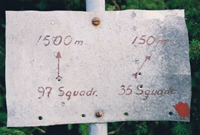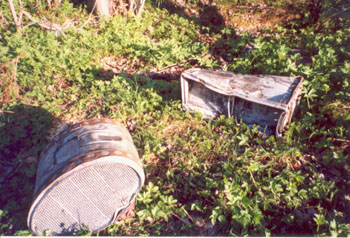W1020 TL-K from 35 Squadron
| On 30th March 1942, the crew of Halifax W1020 TL-K from 35 Squadron took off at approximately 1900 hrs from RAF Kinloss on the North East coast of Scotland to participate in an attack on the German Battleship Tirpitz which was moored at the time in Fættenfjord in Norway.
The aircraft and crew reached the target area and returned safely to RAF Kinloss in the early hours of 31st March 1942. |
|
Rank
|
Name
|
Force | Crew Position | Age |
Home Town
|
Fate |
| F/Lt | POOLES M R M | RAFVR | Pilot | Returned | ||
| Sgt | BIRD | 2nd Pilot | Returned | |||
| P/O | HENRY | Navigator | Returned | |||
| Sgt | RARITY | W/Op Air Gunner | Returned | |||
| Sgt | BLANCHETT | W/Op Air Gunner | Returned | |||
| Sgt | LOWE | Tail Gunner | Returned | |||
| Sgt | BOOTH | Flight Engineer | Returned |
|
Rank
|
Name
|
Force | Crew Position | Age |
Home Town
|
Fate |
| F/Lt | POOLES M R M | RAFVR | Pilot | Died | ||
| P/O | HENRY G J P | RAFVR | Navigator |
21
|
Whalley Range, Manchester, England | Died |
| Sgt | RARITY D E | RAFVR | W/Op Air Gunner | Died | ||
| Sgt | WILSTROP A | RAFVR | W/Op Air Gunner |
22
|
Yarm, Yorkshire, England | Died |
| P/O | HILL F W G | RAFVR | Tail Gunner |
30
|
Putney, London, England | Died |
| Sgt | BOOTH | Flight Engineer | Died |
| This aircraft reached the target area. Possibly it was hit by flak from the AA positions and ships surrounding the fjords damaging the aircraft as it seems that the pilot may have been attempting to head for Sweden perhaps thinking that his aircraft would not make it back over the North Sea. However, the aircraft plunged into a hillside about seven miles from Tirpitz at Borås, Skjekstadmark while heading in the direction of Sweden. The aircraft was still loaded with mines and bombs and exploded violently on impact with the ground. All members of the crew perished in the crash.
The bodies of all the crew members were recovered from the crash and they are buried in Stavne Cemetery in Trondheim. |
| In the days after the crash many local people went to the site despite access to the area being stricly forbidden by the Germans. Ottilie Bergvin was a young woman at the time and she cycled the ten miles from her home at Stjoerdal to the crash site along with the Furunes brothers, Olav, Magnus, Leiv and Dagfinn. The photographs below show the wreckage as they found it that day in 1942. |
|
Ottilie Bergvin looking at the RAF marking on the fuselage of the Halifax.
|
Magnus Furunes (left) and Olav Furunes at the crash site looking at the wreckage.
|
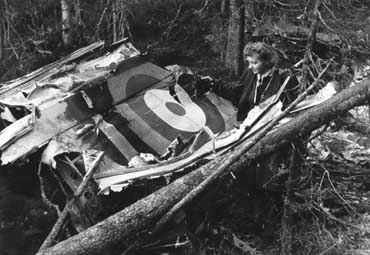 |
 |
|
Photo: S Furunes
|
Photo: S Furunes
|
|
Ottilie Bergvin sitting in the rear turret of the crashed Halifax. Leiv Furunes standing to the right.
|
Olav Furunes in the foreground with Dagfinn Furunes (wearing rucksack) and an unidentified man behind
|
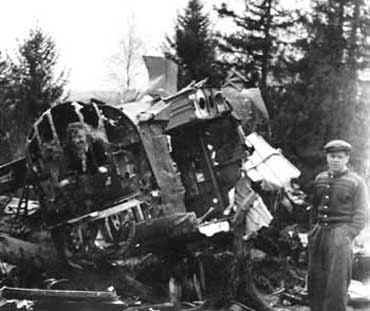 |
 |
|
Photo: S Furunes
|
Photo: S Furunes
|
|
Olav Furunes (left) and Dagfinn Furunes inspecting one of the main wheels which has had the tyre removed from it.
|
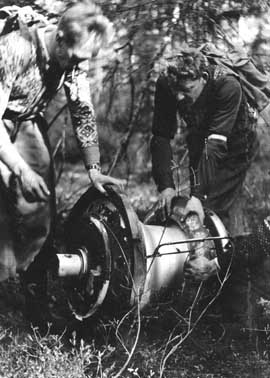 |
|
Photo: S Furunes
|
|
The water post at Borås West Farm. L to R. Dagfinn Furunes, Leiv Furunes, Magnus Furunes, Aase Bardal, John Frigaard, Ottilie Bergvin, & Liv Eidem sitting with Solveig Overrein on her knee.
|
Children from the farms at Borås near where W1020 TL-L crashed. Front L to R. Solveig and Aase Overrein from Borås West Farm, Liv Eidem. Back L to R. John Frigaard from Borås East Farm and Roald Overrein from Borås West.
|
 |
 |
|
Photo: S Furunes
|
Photo: S Furunes
|
|
Evidence of the remains of the aircraft can still be seen today, 2002, at the site of the crash.
|
||||||||||||||||||||||||||||||||||||||||||||||||||||||||||||||||||||||||||||||||||||
|
Today, near to the spot where the aircraft crashed, there is a memorial stone which has the names of the crew members from Halifax W1020 TL-K carved on it. The stone also remembers the crew of Lancaster L7572 OF-L from 97 Squadron which crashed nearby on the same night. In a circle around the memorial stone, which is a large natural granite boulder, there are thirteen small stones placed at regular intervals. Each of these small stones represents the life of an airman who died in the two crashes. It is a very poignant reminder of the lives that were lost that night in April 1942. |
| The Memorial Stone in Norway for the airmen from Halifax W1020 TL-K from 35 Squadron and Lancaster L7572 OF-L from 97 Squadron who died on the night of April 27/28th 1942. |
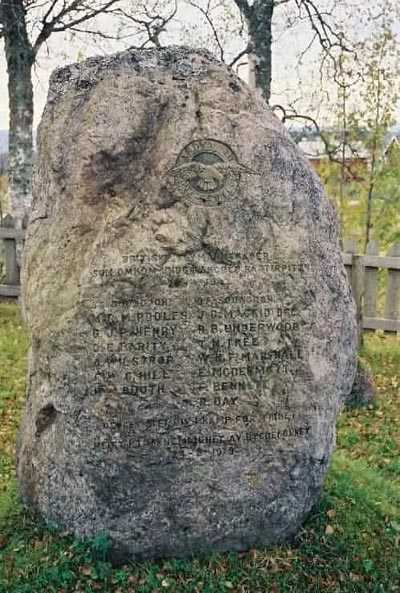 |
|
Photo: T Eggan
|
Back to Top
© Linzee Druce 2001-2012

